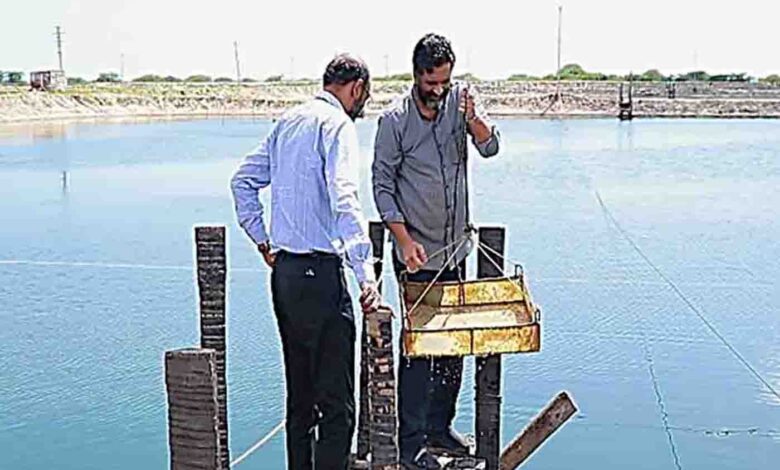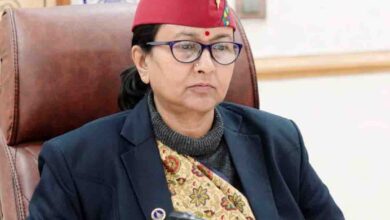Considerable scope for aquaculture in U’khand, Union budget to provide boost to sector

PNS | DEHRADUN
INTYERVIEW

 The Union budget presented recently has increased focus on various sectors to boost sustainable commercial practices. Aquaculture is one of the spheres for which the budget has envisioned measures aimed at expanding its scope and volume. The chairman and managing director of Kings Infra Ventures Limited, Shaji Baby John, who has a special interest in blue economy and sustainable food production systems, interacted with The Pioneer regarding the impact of the Union budget on aquaculture, fisheries and the considerable scope for aquaculture in Uttarakhand.
The Union budget presented recently has increased focus on various sectors to boost sustainable commercial practices. Aquaculture is one of the spheres for which the budget has envisioned measures aimed at expanding its scope and volume. The chairman and managing director of Kings Infra Ventures Limited, Shaji Baby John, who has a special interest in blue economy and sustainable food production systems, interacted with The Pioneer regarding the impact of the Union budget on aquaculture, fisheries and the considerable scope for aquaculture in Uttarakhand.
The Union budget 2025-26 has rolled out various measures to further boost aquaculture. What is your take on this?
The Union budget 2025 can be explained in two perspectives with respect to development of the fish and fisheries sector in India. The Basic Customs Duty (BCD) on a variety of inputs used in hatchery seed production and feed manufacture for hatchery as well as grow-out culture has been reduced. Reduction in customs duty on brood stock import and Artemia along with many hatchery feed components will lead to production of high quality seed at competitive price. The long term impact could be better survival in farms, better and faster growth rates leading to bigger size at harvest and shorter crops. The entire exercise is aimed at making aquaculture more profitable to all stakeholders. The result can be seen with immediate effect in the form of the price of seed and feed coming down relatively and in the longer term with respect to farmers’ income. Secondly, from the investment perspective the budget tends to strike a balance between incentives for aquaculture entrepreneurs and post-harvest technology. Other areas such as sustainability, skill development, research and development etc. have been equally addressed in incentivisation to entrepreneurs. In addition to the benefits from the aquaculture industry, other ministries like the Ministry of Food Processing are also providing several schemes for the development of fisheries infrastructure and the upgradation of existing infrastructure by increasing the subsidy schemes in a big way.
The maritime fund of Rs 25,000 crore is set up to develop the coastal infrastructure including seafood processing facility and cold chain. The development of the coastal infrastructure will help to provide connectivity to fishing harbours, processing entities, export promotion hubs as well as improve the quality of life of the coastal communities. Micro small and medium enterprises play a pivotal role in the country’s economic growth. The Government made it easy for the SMEs to get credit facility without any collateral (CGTMSE scheme) to make funding availability easier for these growth engines. Fish farmers, processors, distributors, wholesalers and retailers can avail this facility to grow their business. Coupled with credit guarantee and interest subvention, SMEs can upgrade their facility, adopt new technology and aim to reach the higher echelon of the seafood market. Another area which has helped the seafood industry is the production linked incentives where additional incentives based on production performance is provided. Under this scheme the companies are supported even to market their seafood products in domestic and international markets with active governmental support. With better marketing and farther reach into the market, the companies are able to offer higher and stable prices to the farmers.
Since frozen shrimp makes up the bulk of the fisheries exports valued at more than Rs 60,000 crore, steps to accelerate shrimp farming are understandable. Is scope in other aspects of aquaculture in addition to shrimp farming?
It is true that shrimps form the bulk of Indian seafood exports while there is a significant contribution from the marine crustaceans and mollusks. Carps are extensively farmed in India which is sold entirely in the domestic market. Another important aquaculture species that needs immediate attention is the freshwater prawns. There is tremendous opportunity to grow finfish like cobia, grouper, sea bass, mullets, milk fish etc. The seed availability, quality feed and proper market promotion are the factors limiting their farming. Farming of mussels and oysters has not been practiced by farmers in the same way it has been practiced in other countries. Seaweed farming is another farming practice that needs to be given due importance. Dedicated exclusive farming hubs can be identified, offered to entrepreneurs in such a way that fish farming, shellfish farming, and seaweed farming can be taken up in suitable areas complementing each other where fish farming waste should generate feed for oysters and mussels, and dissolved nutrients support seaweed growth. Government support in the form of investment, protection and promotion of these sustainable products with proper positioning in the international market can bring about a sea change.
The government is to bring a framework to unlock potential marine sector through sustainable fishing especially in India’s EEZ in Andaman & Nicobar and Lakshadweep. As sustainability remains a challenge in the face of overfishing in the seas, how do you view this decision?
The government’s move is a welcome step. As such overfishing has been a bane in coastal areas of the country which needs to be tackled with multipronged strategies to prevent the stocks from further depletion. These island chains are fragile ecosystem supporting a wide variety of marine biodiversity. Proper study on selection of designated areas and avoidance of indiscriminate policy of encouraging fishing/aquaculture, determining sustainable capacity of the areas identified should be done prior to opening up this region for fishing and aquaculture. By focusing on marine ecosystem conservation, improved management, responsible fishing practices, proper study on choice of fishing gear permitted, these areas could be safeguarded from over exploitation and also their full potential could be realised.
Does aquaculture provide a sustainable option to fishing in the high seas better for both the environment and the consumer, especially considering microplastics and other toxics being found in deep sea fishes?
Aquaculture indeed has the potential to provide a more sustainable alternative to wild fishing in the high seas. It offers benefits to the environment and the consumers. Indiscriminate wild fishing in the high seas, especially through methods like bottom trawling without devices to exclude endangered species- like turtle exclusive devices- without regulation of size being caught has long been linked to overfishing and severe damage to marine ecosystems. Overfishing depletes fish stocks and disrupts marine food webs, often leading to the collapse of certain fish populations. Aquaculture helps relieve pressure on wild fish stocks by cultivating fish and other marine organisms in controlled environments. With appropriate management and sustainable practices, it allows for the consistent production of seafood without depleting wild populations.
Considering measures like financial support to accelerate shrimp farming and export infrastructure along with duty cuts, do you see a boom in aquaculture in the near future?
The measures of financial support and duty cuts will undoubtedly boost production and export considerably. The entrepreneurs’ and the government’s focus should be to incentivise value addition which is lacking in the Indian shrimp industry. Special incentives to install value added product line like cooking line, breaded and battered products, ready to cook and heat and eat products over and above general incentives, special incentives for export of these products over and above the frozen or IQF products could generate more employment, better realisation and encouragement to go for value addition by entrepreneurs.
Do you see scope for aquaculture in non-coastal regions of India, for example in States like Uttarakhand?
Aquaculture has potential to develop as an industry in any part of the world where water is available. Non-coastal regions of India, including States like Uttarakhand are no exceptions. What is required is the will to develop, proper infrastructure support, technology and marketing of the produce. Uttarakhand is a unique State with diverse climatic conditions. It has areas suitable for fresh water aquaculture of fish like carps, tilapia, pangasius, freshwater prawns like all other non-coastal States along with the unique climate to cultivate the cold water fish like trout. Further, there is tremendous scope for breeding and exporting ornamental fishes, freshwater pearl and micro algae like spirulina for pharma and nutraceutical purpose.
What is your advice to an entrepreneur considering aquaculture, especially why and how to take up this activity?
The aquaculture business can be highly rewarding when it is properly planned and managed. An entrepreneur considering entering aquaculture should know that seafood through aquaculture is the one consuming least amount of water compared to any other husbandry practice. Feed conversion in fish farming is the lowest among all farmed animals and provides the cheapest source of animal protein along with minerals, vitamins and essential fatty acids for healthy human growth. The prices are remunerable when the species and culture practice is carefully considered. Several government support structures make it more attractive. One should properly study the market and the demand supply structure, agroclimatic condition of the area and its suitability for a particular species. Technical aspects, best practices and creation of a business plan should be focused upon. The location should be chosen considering water availability, climate, infrastructure and accessibility. The right technology should be chosen and necessary licenses and certifications should be obtained.
How do you see your company Kings Infra Ventures benefit from these proposals?
Kings Infra Ventures Limited is a farming and exporting company engaged in the business for over three decades. The group is the pioneer in shrimp farming in India and currently engaged in various R&D activities to improve shrimp farming efficiency and usher a new technology based farming in India that uses the latest AI and IOT tools in shrimp farm monitoring, and guidance mechanisms. We have been in the forefront of technology development and with the expertise gained over decades we are setting up a one of its kind mariculture eco park at Tuticorin. The mariculture tech park with a capacity to produce 2,200 tonnes of high value shrimp with a total project outlay of Rs 193 crore. This project when operational would offer the best shrimps from India which has a very high export value compared to normal farm grown shrimps. This project also offers training through the skill development centre generating a new breed of aquapreneurs and also improves the employability of the trainees through their career oriented tailor made training courses. This project will also have a nuclear breeding unit for new species development.
The overall development of export culture with support and incentives, the fishers and shrimp farmers have been benefitting as these extra incentives are directly realised as raw material prices in the competitive market. I can foresee Kings Infra achieving multifold growth in aquaculture division by properly channelising the benefits offered in this budget ,to various stakeholders through Kings Maritech Ecoparks and SISTA 360 and also improve processing and export volumes due to better credit and incentives for setting up new export processing facilities.





